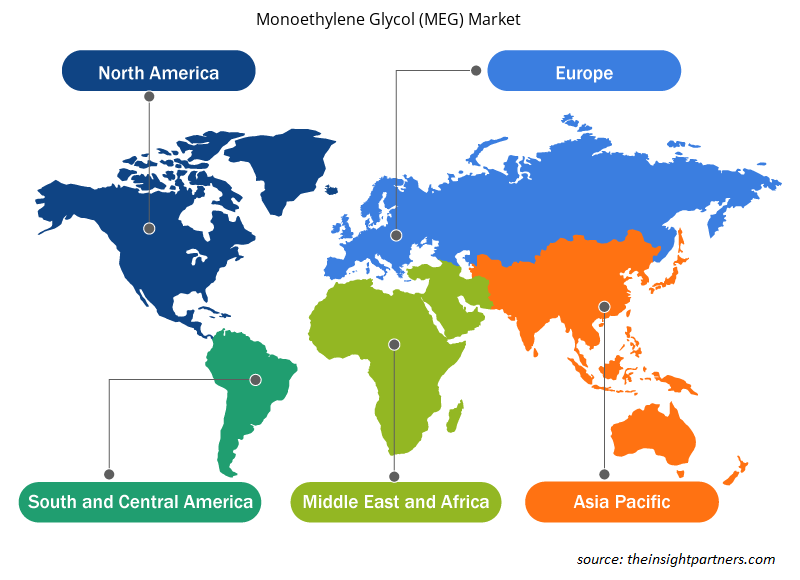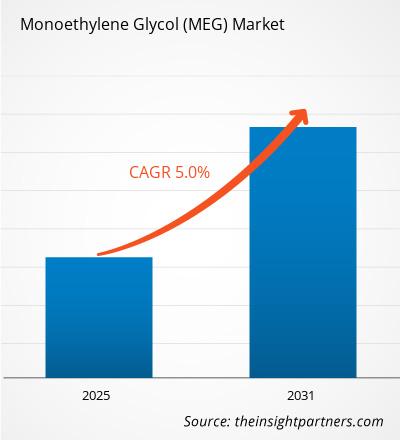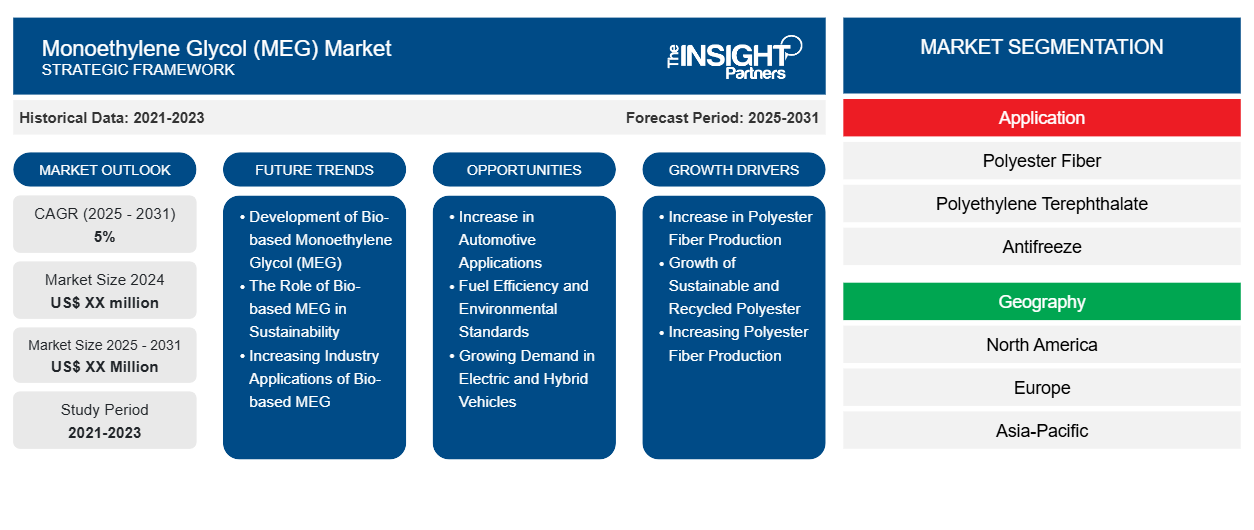Si prevede che il mercato del glicole monoetilenico (MEG) registrerà un CAGR del 5% dal 2024 al 2031, con una dimensione di mercato in espansione da XX milioni di dollari nel 2024 a XX milioni di dollari entro il 2031.
Il report è segmentato per applicazione (fibra di poliestere, polietilene tereftalato (PET), antigelo e altri). L'analisi globale è ulteriormente suddivisa a livello regionale e nei principali paesi. Il report offre il valore in USD per l'analisi e i segmenti di cui sopra.
Scopo del rapporto
Il report Monoethylene Glycol (MEG) Market di The Insight Partners mira a descrivere il panorama attuale e la crescita futura, i principali fattori trainanti, le sfide e le opportunità. Ciò fornirà spunti a vari stakeholder aziendali, come:
- Fornitori/produttori di tecnologia: per comprendere le dinamiche di mercato in evoluzione e conoscere le potenziali opportunità di crescita, consentendo loro di prendere decisioni strategiche informate.
- Investitori: condurre un'analisi completa delle tendenze in merito al tasso di crescita del mercato, alle proiezioni finanziarie del mercato e alle opportunità esistenti lungo la catena del valore.
- Enti di regolamentazione: regolamentano le politiche e le attività di controllo sul mercato allo scopo di ridurre al minimo gli abusi, preservare la fiducia degli investitori e sostenere l'integrità e la stabilità del mercato.
Segmentazione del mercato del glicole monoetilenico (MEG)
Applicazione
- Fibra di poliestere
- Polietilene tereftalato
- Antigelo
Personalizza questo report in base alle tue esigenze
Riceverai la personalizzazione gratuita di qualsiasi report, comprese parti di questo report, o analisi a livello nazionale, pacchetto dati Excel, oltre a usufruire di grandi offerte e sconti per start-up e università
-
Scopri le principali tendenze di mercato in questo rapporto.Questo campione GRATUITO includerà analisi di dati che spaziano dalle tendenze di mercato alle stime e alle previsioni.
Fattori trainanti della crescita del mercato del glicole monoetilenico (MEG)
- Aumento della produzione di fibre di poliestere: un altro importante fattore di crescita del mercato del glicole monoetilenico è la produzione di fibre di poliestere. Il poliestere è uno dei prodotti tessili e di abbigliamento o di arredamento per la casa più ampiamente consumati; quindi, anche il MEG trarrà vantaggio dall'aumento della domanda di fibre di poliestere. L'industria tessile richiede fibre di poliestere per la loro resistenza, versatilità e basso costo. La sintesi del PET, il polimero principalmente utilizzato nella produzione di fibre di poliestere, richiederà quindi una chiave MEG. Ci si aspetta che l'aumento del livello di produzione per soddisfare la domanda dei consumatori si riversi nel corrispondente aumento della domanda di MEG.
- Crescita del poliestere sostenibile e riciclato: un altro motore del mercato MEG è la crescente popolarità del poliestere sostenibile e riciclato. Oggigiorno, sempre più aziende producono questo tipo di riciclabili, utilizzando PET riciclato, che necessita comunque di MEG per la sua lavorazione. Questo approccio, oltre a fornire il giusto tipo di supporto per l'iniziativa ambientale, sottolinea il ruolo che MEG ha svolto nell'economia circolare, ovvero la sua crescita di mercato.
- Aumento della produzione di fibre di poliestere: la produzione di fibre di poliestere può essere un forte motore di crescita nel mercato del glicole monoetilenico. Con l'aumento della produzione tessile e l'espansione dei processi di produzione, la domanda di MEG come materia prima importante continuerà ad aumentare, il che a sua volta offre notevoli opportunità per i produttori in questo settore.
Tendenze future del mercato del glicole monoetilenico (MEG)
- Sviluppo di glicole monoetilenico (MEG) di origine biologica: lo sviluppo di glicole monoetilenico di origine biologica è emerso come un importante motore di crescita nel mercato del glicole monoetilenico. Le industrie hanno recentemente mostrato maggiore interesse per la sostenibilità e, quindi, lo sviluppo di MEG di origine biologica da fonti rinnovabili sta emergendo come un'alternativa ecologica al MEG ampiamente utilizzato a base di petrolio, un prodotto molto attraente sia per i consumatori che per i produttori attenti all'ambiente.
- Il ruolo del MEG di origine biologica nella sostenibilità: il MEG di origine biologica si adatta bene a questo mondo sostenibile; i produttori sono desiderosi di ridurre l'impronta di carbonio della loro azienda. Il MEG di origine biologica contribuisce a rompere la dipendenza dai combustibili fossili, mentre viene sostenuto nel campo dell'economia circolare attraverso l'utilizzo di rifiuti e sottoprodotti agricoli. Sta già iniziando ad attrarre più investimenti e ricerche su questo fronte.
- Applicazioni industriali crescenti di MEG di origine biologica: il MEG di origine biologica è ampiamente utilizzato nelle formulazioni delle industrie tessili e degli imballaggi. Poiché sempre più consumatori sollevano preoccupazioni in merito alla sostenibilità dei prodotti offerti, i produttori stanno integrando materiali di origine biologica nelle loro linee di produzione per un migliore posizionamento sul mercato. Il MEG di origine biologica è utilizzato nella produzione di fibre di poliestere e PET. Pertanto, contribuisce in modo significativo alla produzione di tessuti e materiali di imballaggio ecocompatibili.
Opportunità di mercato del glicole monoetilenico (MEG)
- Aumento delle applicazioni automobilistiche: le applicazioni automobilistiche stanno fortemente guidando le opportunità di crescita nel mercato della monoetanolammina. MEA è utilizzato in diverse applicazioni di formulazione di automobili come additivi per carburante, refrigeranti per motori e agenti anticorrosione. Con il passare del tempo, a causa delle mutevoli esigenze dell'industria automobilistica, si prevede che sarà richiesta una maggiore domanda di prodotti chimici ad alte prestazioni, come MEA, e che il suo mercato ne verrà potenziato.
- Efficienza del carburante e standard ambientali: il requisito di efficienza del carburante e minori emissioni costringe il produttore a incorporare MEA nelle formulazioni del carburante. MEA fornisce una maggiore efficienza di combustione e riduce i depositi del motore, il che è fondamentale per far fronte a rigorosi standard ambientali. La domanda di MEA nelle applicazioni automobilistiche aumenterà poiché i produttori di automobili intendono migliorare le prestazioni dei veicoli riducendo al contempo i loro effetti negativi sull'ambiente.
- Domanda crescente di veicoli elettrici e ibridi: inoltre, i veicoli elettrici e le tecnologie ibride sono di crescente interesse. Viene utilizzato nella formulazione di fluidi di raffreddamento ed elettroliti per la batteria, un componente essenziale per il funzionamento efficiente dei veicoli elettrici. Poiché il mercato dei veicoli elettrici e ibridi continua a crescere, è probabile che i requisiti per prodotti chimici speciali come MEA aumentino.
Approfondimenti regionali sul mercato del glicole monoetilenico (MEG)
Le tendenze regionali e i fattori che influenzano il mercato del glicole monoetilenico (MEG) durante il periodo di previsione sono stati ampiamente spiegati dagli analisti di Insight Partners. Questa sezione discute anche i segmenti di mercato del glicole monoetilenico (MEG) e la geografia in Nord America, Europa, Asia Pacifico, Medio Oriente e Africa e America meridionale e centrale.

- Ottieni i dati specifici regionali per il mercato del glicole monoetilenico (MEG)
Ambito del rapporto di mercato del glicole monoetilenico (MEG)
| Attributo del report | Dettagli |
|---|---|
| Dimensioni del mercato nel 2024 | XX milioni di dollari USA |
| Dimensioni del mercato entro il 2031 | XX milioni di dollari USA |
| CAGR globale (2025 - 2031) | 5% |
| Dati storici | 2021-2023 |
| Periodo di previsione | 2025-2031 |
| Segmenti coperti |
Per applicazione
|
| Regioni e Paesi coperti |
America del Nord
|
| Leader di mercato e profili aziendali chiave |
|
Densità degli attori del mercato del glicole monoetilenico (MEG): comprendere il suo impatto sulle dinamiche aziendali
Il mercato del glicole monoetilenico (MEG) sta crescendo rapidamente, spinto dalla crescente domanda degli utenti finali dovuta a fattori quali l'evoluzione delle preferenze dei consumatori, i progressi tecnologici e una maggiore consapevolezza dei benefici del prodotto. Con l'aumento della domanda, le aziende stanno ampliando le loro offerte, innovando per soddisfare le esigenze dei consumatori e capitalizzando sulle tendenze emergenti, il che alimenta ulteriormente la crescita del mercato.
La densità degli operatori di mercato si riferisce alla distribuzione di aziende o società che operano in un particolare mercato o settore. Indica quanti concorrenti (operatori di mercato) sono presenti in un dato spazio di mercato in relazione alle sue dimensioni o al valore di mercato totale.
Le principali aziende che operano nel mercato del glicole monoetilenico (MEG) sono:
- LyondellBasell,
- La Dow Chemical Company,
- ME Global
- SABICO,
- Società ExxonMobil,
Disclaimer : le aziende elencate sopra non sono classificate secondo un ordine particolare.

- Ottieni una panoramica dei principali attori del mercato del glicole monoetilenico (MEG)
Punti chiave di vendita
- Copertura completa: il rapporto copre in modo completo l'analisi di prodotti, servizi, tipologie e utenti finali del mercato del glicole monoetilenico (MEG), fornendo una panoramica olistica.
- Analisi degli esperti: il rapporto è compilato sulla base della conoscenza approfondita di esperti e analisti del settore.
- Informazioni aggiornate: il rapporto garantisce la pertinenza aziendale grazie alla copertura di informazioni recenti e tendenze nei dati.
- Opzioni di personalizzazione: questo report può essere personalizzato per soddisfare le esigenze specifiche del cliente e adattarsi in modo appropriato alle strategie aziendali.
Il rapporto di ricerca sul mercato del glicole monoetilenico (MEG) può quindi aiutare a guidare il percorso di decodificazione e comprensione dello scenario del settore e delle prospettive di crescita. Sebbene possano esserci alcune preoccupazioni valide, i vantaggi complessivi di questo rapporto tendono a superare gli svantaggi.
- Analisi storica (2 anni), anno base, previsione (7 anni) con CAGR
- Analisi PEST e SWOT
- Valore/volume delle dimensioni del mercato - Globale, Regionale, Nazionale
- Industria e panorama competitivo
- Set di dati Excel
Report recenti
Testimonianze
Motivo dell'acquisto
- Processo decisionale informato
- Comprensione delle dinamiche di mercato
- Analisi competitiva
- Analisi dei clienti
- Previsioni di mercato
- Mitigazione del rischio
- Pianificazione strategica
- Giustificazione degli investimenti
- Identificazione dei mercati emergenti
- Miglioramento delle strategie di marketing
- Aumento dell'efficienza operativa
- Allineamento alle tendenze normative























 Ottieni un campione gratuito per - Mercato del glicole monoetilenico (MEG)
Ottieni un campione gratuito per - Mercato del glicole monoetilenico (MEG)